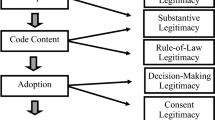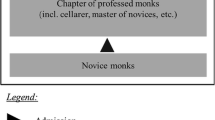Abstract
The focus of this paper is to further a discussion of codes of ethics as institutionalized organizational structures that extend some form of legitimacy to organizations. The particular form of legitimacy is of critical importance to our analysis. After reviewing various theories of legitimacy, we analyze the literature on how legitimacy is derived from codes of ethics to discover which specific form of legitimacy is gained from their presence in organizations. We content analyze a sample of codes to consider the question of whether a strategic, self-interested rationale lies behind the adoption of a code of ethics. We propose that the process of employing codes of ethics in this strategic manner has become, through isomorphism, an institutionalized practice that itself confers a cognitive form of legitimacy to the organization and further distances the codes from their moral foundation.
Similar content being viewed by others
References
2005, ‚Doing it Right: The TOP 101 Companies of Atlantic Canada Ranked by Revenue’, Progress 12(7), 113–126
Abbott A.: 1988, The System of Professions: An Essay on the Division of Expert Labour. The University of Chicago Press, Chicago, IL
Academy of Management: 2006, ‚Code of Ethics Program Comparison’, available at www.aomonline.org/aom.asp?ID = 257&page_ID = 242
Anand V., Ashforth B. E., Joshi M.: 2005, Business as Usual: The Acceptance and Perpetuation of Corruption in Organizations. The Academy of Management Executive 19(4), 9–23
Ashforth B. E., Gibbs B. W.: 1990, The Double-Edge of Organizational Legitimation. Organization Science 1, 177–194
Astley W. G., Van de Ven A. H.: 1983, Central Perspectives and Debates in Organization Theory. Administrative Science Quarterly 28, 245–273
Bauer M. W.: 2000, Classical Content Analysis: A Review”. In M. W. Bauer, G. Gaskell (eds.), Qualitative Researching with Text, Image and Sound: A Practical Handbook. Sage Publications, London, pp. 131–151
Berger P., Luckmann T.: 1966, The Social Construction of Reality: A Treatise in the Sociology of Knowledge. Doubleday and Company, Garden City, NY
Boiral O.: 2003, The Certification of Corporate Conduct: Issues and Prospects. International Labour Review 142(3), 317–341
Burrell G., Morgan G.: 1979, Sociological Paradigms and Organizational Analysis: Elements of the Sociology of Corporate Life. Heinemann, London
Dacin M. T.: 1997, Isomorphism in Context: The Power and Prescription of Institutional Norms. Academy of Management Journal 40(1), 46–81
Daft R. L., Weick K. E.: 1984, Toward a Model of Organizations as Interpretation Systems. Academy of Management Review 9(2), 284–295
Deephouse D. L., Carter S.: 2005, An Examination of Differences between Organizational Legitimacy and Organizational Reputation. The Journal of Management Studies 42(2), 329–341
DiMaggio P.: 1988, Interest and Agency in Institutional Theory. In L. Zucker (ed.), Institutional Patterns and Organizations: Culture and Environment. Ballinger Publishing Company, Cambridge, MA, pp. 3–21
DiMaggio P., Powell W.: 1983, The Iron Cage Revisited: Institutional Isomorphism and Collective Rationality in Organizational Fields. American Sociological Review 48(2), 147–160
Donaldson T.: 1983, Constructing a Social Contract for Business. In T. Donaldson, P. Werhane (eds.), Ethical Issues in Business. Oxford University Press, New York, NY, pp. 153–165
Dowling J. B., Pfeffer J.: 1975, Organizational Legitimation. Pacific Sociological Review 18(1), 122–136
Elsbach J. M., Sutton R. I.: 1992, Acquiring Organizational Legitimacy through Illegitimate Actions: A Marriage of Institutional and Impression Management Theories. Academy of Management Journal 35(4), 699–738
Fairclough N.: 1992, Discourse and Social Change. Polity Press, Cambridge, MA
Fogarty T. J.: 1995, Accountant Ethics: A Brief Examination of Neglected Sociological Dimensions. Journal of Business Ethics 14(2), 103–116
Glynn M. A., Azbug R.: 2002, Institutionalizing Identity: Symbolic Isomorphism and Organizational Names. Academy of Management Journal 45(1), 267–280
Guthrie J., Petty R., Yongvanich K., Ricceri F.: 2004, Using Content Analysis as a Research Method to Inquire into Intellectual Capital Reporting. Journal of Intellectual Capital 5(2), 282–293
Johnson P., Smith K.: 1999, Contextualizing Business Ethics: Anomie and Social Life. Human Relations 52(11), 1351–1376
Kaptein M.: 2004, Business Codes of Multinational Firms: What Do They Say?. Journal of Business Ethics 50(1), 13–33
Kelly M.: 2005, The Ethics Revolution. Business Ethics 19(2), 6
Lindsay R. M., Lindsay L. M., Irvine B.: 1996, Instilling Ethical Behaviour in Organizations: A Survey of Canadian Companies. Journal of Business Ethics 15(4), 393–408
Meyer J. W., Rowan B.: 1977, Institutionalized Organizations: Formal Structure as Myth and Ceremony. American Journal of Sociology 83, 340–363
Neilson E. H., Rao M. V. H.: 1987, The Strategy-Legitimacy Nexus: A Thick Description. Academy of Management Review 15, 523–533
Nystrom, P. and W. Starbuck: 1984, ‚Organizational Facades’, Proceedings of the Academy of Management Conference, Boston, MA, pp. 182–186
O’Donovan G.: 2002, Environmental Disclosures in the Annual Report: Extending the Applicability and Predictive Power of Legitimacy Theory. Accounting, Auditing and Accountability Journal 15(3), 344–372
Oliver C.: 1991, Strategic Responses to Institutional Processes. Academy of Management Review 16, 145–179
Pfeffer J., Salancik G. R.: 1978, The External Control of Organizations: A Resource Dependence Perspective. Harper and Row, New York, NY
Preston A. M., Cooper D. J., Scarbrough D. P., Chilton R. C.: 1995, Changes in the Code of Ethics of the U.S. Accounting Profession, 1917 and 1998: The Continual Quest for Legitimation. Accounting, Organizations and Society 20(6), 507–546
Sacconi L.: 1999, Codes of Ethics as Contractarian Constraints on the Abuse of Authority within Hierarchies: A Perspective from the Theory of the Firm. Journal of Business Ethics 21(2/3), 189–203
Schwartz M.: 2002, A Code of Ethics for Corporate Code of Ethics. Journal of Business Ethics 41(1/2), 27–44
Schwartz M.: 2004, Effective Corporate Codes of Ethics: Perceptions of Code Users. Journal of Business Ethics 55(4), 323–343
Scott R.: 1995, Institutions and Organizations. Sage Publications, Thousand Oaks, CA
SEDAR: n.d., available at www.sedar.com/homepage_en.htm
Selznick P.: 1966, TVA and the Grassroots: A Study in the Sociology of Formal Organization. Harper and Row, New York, NY
Silverman D.: 1970, The Theory of Organizations. Basic Books, New York, NY
Suchman M.: 1995, Managing Legitimacy: Strategic and Institutional Approaches. Academy of Management Review 20, 571–610
Tolbert P. S., Zucker L.: 1983, Institutional Sources of Change in the Formal Structure of Organizations: The Diffusion of Civil Service Reform, 1880–1935. Administrative Science Quarterly 28(1), 22–39
Warren R.: 2003, The Evolution of Business Legitimacy. European Business Review 15(3), 153–163
Wartick S. L., Cochran P. L.: 1985, The Evolution of the Corporate Social Performance Model. Academy of Management Review 10, 758–769
Weaver G. R., Trevino L. K., Cochran P. L.: 1999, Corporate Ethics Programs as Control Systems: Influences of Executive Commitment and Environmental Factors. Academy of Management Journal 42(1), 41–57
Weber, M.: 1956, Economy and Society: An Outline of Interpretive Sociology, Vol. 1 (University of California Press, Berkeley, CA) 1978 printing
Weber R. P.: 1990, Basic Content Analysis. 2. Sage, Newbury Park, CA
Wood D. J.: 1991, Corporate Social Performance Revisited. Academy of Management Review 16, 691–718
Zucker L.: 1988, Where Do Institutional Patterns Come From? Organizations as Actors in Social Systems. In L. Zucker (ed.), Institutional Patterns and Organizations: Culture and Environment. Ballinger Publishing Company, Cambridge, MA, pp. 23–49
Acknowledgements
The authors would like to thank the two anonymous reviewers for their constructive efforts to improve this paper.
Author information
Authors and Affiliations
Corresponding author
Rights and permissions
About this article
Cite this article
Long, B.S., Driscoll, C. Codes of Ethics and the Pursuit of Organizational Legitimacy: Theoretical and Empirical Contributions. J Bus Ethics 77, 173–189 (2008). https://doi.org/10.1007/s10551-006-9307-y
Received:
Accepted:
Published:
Issue Date:
DOI: https://doi.org/10.1007/s10551-006-9307-y




